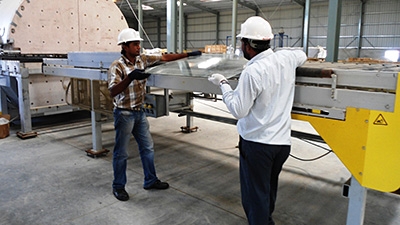To achieve these goals, India needs to build domestic capacity to supply its own CSP components rather than import most of them, as is now the case. In addition to its energy benefits, such local manufacturing would also boost India’s economic growth.
India has already brought down the cost of solar power substantially through the first phase bidding under the JNNSM, which was conducted under a reverse auction model. The World Bank report estimates that with local manufacturing of components, the cost of CSP components in India could fall by 15-30 percent from present levels. It argues that with the right support, this local supply chain could be up and running in 4-7 years. The study was carried out by the World Bank’s South Asia Sustainable Development Department and financed by the Energy Sector Management Assistance Program (ESMAP).
"Project implementation until now has been held back by a lack of experience with the technology," said Tarun Kapoor, Joint Secretary of the Ministry of New and Renewable Energy (MNRE), who heads the implementation of grid-connected solar power for the JNNSM. "However, if we can overcome this, there is great potential for CSP in India."
A similar ESMAP study on CSP manufacturing potential in the Middle East and North Africa region conducted in 2010 was widely disseminated and used to develop enabling policies for the scale-up of CSP in Morocco. It was instrumental in the World Bank’s support – through loans totaling almost US$300 million -- for the 500 megawatt (MW) Ouarzazate I complex in Morocco, among the largest CSP plants in the world.
The starting point of the present study was a detailed analysis of the capability of industries in India to develop CSP technologies and manufacture critical components. The conclusion was that most components could be manufactured in India in the near- to medium-term. These included turbines, drive systems, and parabolic trough mirrors. Some policy adjustments would be required, like lowering the customs duties on low-iron sand required to manufacture the mirrors.
More fundamentally, Indian industries would need to be engaged and actively participate in developing this new market. The study identifies a number of existing industries that could find opportunities in CSP component manufacturing, including automotive, glass, metal, electronics, chemical and machine tool companies. Moving forward, to meet the challenge of international competition, research and development, and collaboration between companies and R&D labs, would need to be increased to develop cheaper and more efficient components. The study estimates that if local design and intellectual property are brought into these new supply chains, the cost of some CSP components could drop by as much as 40 percent.
The report estimates that starting up local manufacturing for most CSP components would require less than 500 MW/year of demand. However, certain components, such as receiver tubes and tracking devices, would require significant initial R&D or a licensing agreement with international manufacturers.
The report also analyzed the domestic economic benefits of CSP manufacturing for India, laying out “pessimistic”, “moderate” and “optimistic” scenarios. The moderate scenario estimates 6,000 MW of installed CSP capacity by 2022, creating around 60,000 jobs.
Two workshops were conducted as part of the study, which brought together representatives from industry and government to discuss how a CSP market could be kick-started in India. These workshops resulted in a number of recommendations that are reflected in the report, including support for demonstration plants using hybrid and new technologies, quality standards for locally-produced components, and incentives for companies investing in R&D in this area.
The report was presented to government officials in New Delhi on September 27, 2013, at an event headed by Joint Secretary Kapoor and the World Bank Country Director for India, Onno Ruhl.



